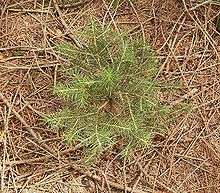Mast (botany)
Mast is the "fruit of forest trees like acorns and other nuts".[1] It is also defined as "the fruit of trees such as beech, and other forms of Fagaceae". Alternatively, it can also refer to "a heap of nuts".[1] The term "mast" comes from the old English word "mæst", meaning the nuts of forest trees that have accumulated on the ground, especially those used as food for fattening domestic pigs.[2]
More generally, mast is considered the edible vegetative or reproductive part produced by woody species of plants, i.e. trees and shrubs, that wildlife species and some domestic animals consume. It comes in two forms.
Hard mast

Tree species such as oak, hickory, and beech produce a hard mast—acorns, hickory nuts, and beechnuts. It has been traditional to turn pigs loose into forests to fatten on this form of mast. Also branch tips of the latest year's growth are eaten by some wildlife, such as deer.
Soft mast
Other tree and shrub species produce a soft mast—leaf buds, catkins, true berries, drupes, and rose hips.
Mast seeding
A mast year is a year in which much more mast than usual is produced. The phrase originally applied solely to trees, like oak trees, that produce fruit useful for feeding farm animals.
Mast seeding or masting[3] is a mass-seeding phenomenon exhibited by some species of plants, which can be defined as "synchronous production of seed at long intervals by a population of plants".[4] Masting, in the strict sense of the term, occurs only in monocarpic (or semelparous) species, whose members reproduce only once during their lifetime, then die.[5]
The prolific seeding provides food for animals like rats and stoats, whose populations can explode during a mast year, having been reduced by a lack of food in previous non-mast years. In turn, this makes it more likely that birds will be targeted by the pests,[6] or that rats will invade nearby fields in what is called a "rat flood".[7]
The interaction between disturbance by fire and masting is key to white spruce regeneration and subsequent stand dynamics in the boreal mixedwood forest. Peters et al. (2005)[8] found significantly higher densities of white spruce in stands originating from fires that coincided with mast years than from fires coinciding with years of low cone crops. While noting that previous studies had assessed a 3 to 5-year window of opportunity for obtaining white spruce regeneration after fire before seedbed deterioration closed it, Peters et al. (2005)[8] adduced 3 lines of evidence to support their claim that the importance of the fire×mast-year interaction hinged on the rapid deterioration of the seedbed, even within one year after fire. Rapid seedbed deterioration is likely to augment the mast-year effect for white spruce as compared with species that are less dependent on short-lived, disturbance-created regeneration microsites. Seed limitation, as well as seedbed deterioration influences age structure in white spruce. Mast-year effects on the density of white spruce are long-lasting; 40 years after fire, mast-year fires still had 2.5 times more spruce regeneration than non-mast-year fires.[8]
See also
References
- 1 2 Swartz, Delbert (1971). Collegiate Dictionary of Botany. New York: The Ronald Press Company. p. 284.
- ↑ "mast". Oxford English Dictionary (3rd ed.). Oxford University Press. September 2005. (Subscription or UK public library membership required.)
- ↑ Kelly, Dave (1994). "The evolutionary ecology of mast seeding". Trends in Ecology & Evolution. 9 (12): 465–470. doi:10.1016/0169-5347(94)90310-7.
- ↑ Janzen, D. H. (1976). "Why Bamboos Wait So Long to Flower". Annual Review of Ecology and Systematics. 7 (1): 347–391. doi:10.1146/annurev.es.07.110176.002023. JSTOR 2096871.
- ↑ Strobilanthes callosus; Botany Photo of the Day. Notes posted by Daniel Mosquin. January 13, 2009.
- ↑ Reich, Josh (16 January 2009). "Trappers face pest population explosion". The Nelson Mail. Retrieved 2009-02-11.
- ↑ Normile, D. (February 2010). "Holding back a torrent of rats". Science. 327 (5967): 806–7. doi:10.1126/science.327.5967.806. PMID 20150483.
- 1 2 3 Peters, Vernon S.; Macdonald, S. Ellen; Dale, Mark R. T. (2005). "The interaction between masting and fire is key to white spruce regeneration". Ecology. 86 (7): 1744–1750. doi:10.1890/03-0656. JSTOR 3450618.
External links
| Look up mast in Wiktionary, the free dictionary. |